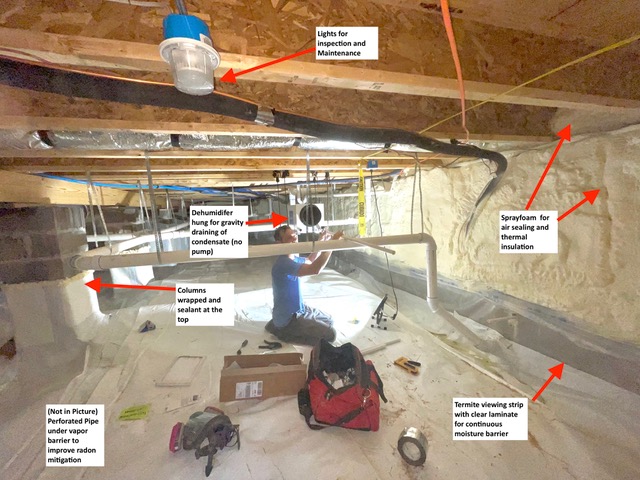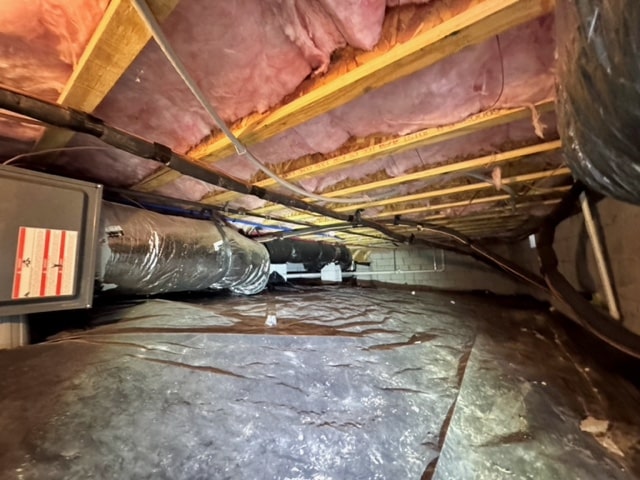In Middle Tennessee, the majority of homes are built on crawlspaces. Our rocky soil makes digging basements difficult, and our climate sits at the northern edge where slab-on-grade construction makes sense due to cold weather risks. Crawlspaces offer some great advantages, but they also come with challenges that, if ignored, can seriously impact your home’s comfort, durability, and air quality. Crawlspaces are often the most neglected part of a house, yet they play a critical role in its overall performance. The crawlspace is a major structural element of a home and it makes up the bottom of the thermal enclosure – in other words, the boundary between inside and outside.
Two Approaches: Vented vs. Encapsulated Crawlspaces
There are two systems that are used to handle the insulation and air sealing of a crawlspace. It is important to note that these systems function very differently so they cannot be hybridized. One or the other must be chosen.
Vented Crawlspaces
In this system, the crawlspace is treated as outdoor space, relying on outside air to control humidity. The thermal boundary is at the subfloor (crawlspace ceiling), requiring careful air sealing of wire, plumbing and any other penetrations through the sub floor. The insulation is also installed in the sub floor, typically fiberglass batts. Any ductwork, insulation, or plumbing in this space will be subjected to the outside elements.
Pros:
- Lower initial cost
- In certain circumstances these systems can provide reasonable performance
Cons:
- Humidity control depends on outside conditions
- Variable humidity can cause movement of hardwood flooring
- Requires dry ground to function in our climate
- Fiberglass batts can trap moisture and lead to wood rot
- Ductwork in the crawlspace is exposed to outside conditions
- Leakage will introduce contaminates to inside air
- Energy losses
- Plumbing is exposed to outside conditions and can freeze in very cold weather
- Cold floors in winter cause comfort problems
- More likely to harbor pests
Encapsulated Crawlspaces
In this system, the crawlspace is treated as indoor space, with a sealed vapor barrier over the ground and sprayfoam insulation on the walls to seal and insulate. The thermal boundary is at the crawlspace walls so the crawlspace stays at a temperature close to the indoor living space. The ground below and living space above are plenty to keep the temperature in a comfortable range. In many cases, a dehumidifier is needed to make sure humidity levels stay in an acceptable range even though the humidity load is much lower than a vented crawlspace.
Pros:
- Humidity is managed (often with a dedicated dehumidifier) and not exposed to outside elements
- Reduces moisture load on the building
- Reduces risk of mold, rot and bowing of structural elements
- Greatly improves indoor air quality by eliminating a major source of contaminates
- It includes most of the major components of a radon mitigation system
- Provides space for ductwork inside the thermal envelope which greatly benefits efficiency and indoor air quality
- Improved comfort by keeping floors warm in the winter
- Easier and safer space for maintenance and inspections (plumbing, HVAC, Electrical, pest control)
Cons:
- Higher upfront cost
- Requires careful execution of details to achieve all the goals
- Maintenance of dehumidifier (if needed)
Regional Considerations for Middle Tennessee
Radon
Radon is a radioactive, odorless gas that can enter homes through exposed soil. Middle Tennessee is designated a Zone 1 radon area (highest risk) by the EPA. Radon can be managed with both vented and sealed crawlspaces. The first step to a radon mitigation system is a well-sealed vapor barrier like that of an encapsulated crawlspace. Sometimes this will control radon sufficiently, but often sub-barrier depressurization is required to bring radon levels down to safe levels. This can be built into the encapsulated crawlspace system with minimal added cost.
Humidity
Humidity is the #1 challenge in the Middle Tennessee region for home performance. Summer dew points of outside air often get into the lower to mid 70s. This is close to or above the temperature found in most crawlspaces so when outside air enters the crawlspace the water vapor will condense on any surface below the dewpoint. In a vented crawlspace, outside air is brought into the crawlspace with the intention to dry it out but it often makes it wetter. Even with a well-sealed vapor barrier on the ground, moisture from outside air can cause condensation on cool surfaces like ductwork or fiberglass insulation, leading to mold growth and structural damage.
Considering these major issue specific to this region, E3 building scientists feel strongly that encapsulated crawlspaces are a much better solution in Middle Tennessee.
Benefits of Encapsulation
Indoor Air Quality
From Radon to mold to dust and humidity, vented crawlspaces are hotbeds for indoor air contaminates. Encapsulating the crawlspace allows you to take control of the space and eliminate the source of many indoor air contaminates.
Comfort
Fiberglass batts in a vented crawlspace are prone to gaps and sagging. Often contractors and homeowners will remove the insulation completely to mitigate the risk of mold growth in the crawlspace. In the winter this leaves the floors exposed to outside conditions which creates a major issue for comfort inside. With encapsulated crawlspaces the floors are not the separation between the inside and outside, therefore remain warm in the winter.
Durability
When wood floor joists are exposed to high humidity, they are more prone to bend and sag. The high humidity of a vented crawlspace can also lead to rot and mold growth that damages the structural integrity of the wood.
Pest Control
Vented crawlspaces create a cozy environment for insects and small animals. Encapsulation seals up entry points and eliminates moisture, reducing pest activity and the risk of termite damage.
Energy Efficiency
Ducts in vented crawlspaces lose conditioned air to the outside. With encapsulation, ductwork stays inside the thermal envelope, saving energy and improving system performance.
Freeze Protection
With a vented crawlspace the plumbing inside the crawlspace is exposed to outside conditions and can freeze when there is a deep cold snap. In an encapsulated crawlspace the plumbing is all inside the thermal envelope, so the pipes are protected from freezing.
Serviceability
Encapsulated crawlspaces are clean, dry, and well-lit, making it easier to spot plumbing leaks, signs of pests, or other issues early. Technicians are more likely to do high-quality work in a comfortable environment.
Final Thoughts
While vented crawlspaces might be cheaper upfront, they often cost homeowners more over time in repairs, energy bills, and comfort issues. If you are building, renovating, or dealing with crawlspace concerns, encapsulation is worth serious consideration — especially in a climate like Middle Tennessee’s.
There are many crawlspace encapsulation companies – however the finished products vary greatly in how well they perform. Many of them will focus on one or two of the benefits and ignore the others. Some of the common short cuts that crawlspace companies take include:
- Using a vapor barrier material that is not suitable for long term durability
- Skipping sprayfoam insulation on the walls and rim band
- Not installing piping for radon mitigation system before installing the vapor barrier
- Not sealing the opening in the foundation for package HVAC systems
- Not installing a sealed and insulated door
- Using supply air from the HVAC system to condition the space instead of adding a dehumidifier
It is important to hire a company like E3, where our building scientists understand all the benefits and can keep them in mind when designing and installing your crawlspace system. Click here to learn more about E3’s approach to crawlspaces.











